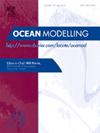东亚边缘海长期连续观测资料的同化效应
IF 2.9
3区 地球科学
Q2 METEOROLOGY & ATMOSPHERIC SCIENCES
引用次数: 0
摘要
尽管自20世纪60年代以来东亚边缘海的连续观测系统具有长期的重要性,但对这一宝贵数据对海洋分析的贡献的研究仍然有限。本研究通过观测系统模拟实验(OSSE)来评估该系列观测系统的数据同化效果。将OSSE应用于22条不同同化周期的连续观测线。结果表明,同化效果最好的周期为2个月,与实际观测系统的周期吻合。在表层,由于东/日本海北部偏暖增加,10天周期和1个月周期表现较差。相比之下,对于500 m以下没有连续观测数据的深层,10天和1个月的周期在2012-2018年前7年的短期模拟中表现更好。这种改善与东部/日本海北部产生的下行洋流有关。在2019 ~ 2041年的长期模拟中,2个月的周期表现出优越的性能,可能是由于向南的深流传播的信号,这是经向翻转环流的一部分。这些发现也得到了反向偏倚实验结果的支持,尽管解释数据同化过程的物理机制不同。该研究为长期海洋预报提供了有价值的见解,并突出了序列观测系统在加强海洋分析方面的意义。本文章由计算机程序翻译,如有差异,请以英文原文为准。
Assimilation effect of serial observation data in the East Asian Marginal Seas for long period
Despite the long-standing importance of the serial observation system since the 1960s in the East Asian Marginal Seas (EAMSs), research on the contribution of this valuable data to ocean analysis remains limited. In this study, an Observing System Simulation Experiment (OSSE) was conducted to assess the data assimilation effects of this serial observation system. The OSSE was applied to 22 serial observation lines, with different assimilation periods.
Results show that the best assimilation performance was achieved with the 2-month cycle, which matches the real observation system's period. In the surface layer, the 10-day and 1-month cycles exhibited poorer performance due to an increase in warm bias in the northern part of the East/Japan Sea. In contrast, for the deep layer below 500 m where no serial observation data is available, the 10-day and 1-month cycles showed better performance in short-term simulations for the first seven years for 2012–2018. This improvement is linked to the downward current generated in the northern East/Japan Sea.
In long-term simulations for 2019∼2041, the 2-month cycle demonstrated superior performance, likely due to signal propagation by the southward deep current, which is part of the meridional overturning circulation. These findings were also supported by results from the reverse bias experiment, although the physical mechanisms for interpreting the data assimilation process differ. This study provides valuable insights for long-term ocean prediction and highlights the significance of the serial observation system in enhancing ocean analysis.
求助全文
通过发布文献求助,成功后即可免费获取论文全文。
去求助
来源期刊

Ocean Modelling
地学-海洋学
CiteScore
5.50
自引率
9.40%
发文量
86
审稿时长
19.6 weeks
期刊介绍:
The main objective of Ocean Modelling is to provide rapid communication between those interested in ocean modelling, whether through direct observation, or through analytical, numerical or laboratory models, and including interactions between physical and biogeochemical or biological phenomena. Because of the intimate links between ocean and atmosphere, involvement of scientists interested in influences of either medium on the other is welcome. The journal has a wide scope and includes ocean-atmosphere interaction in various forms as well as pure ocean results. In addition to primary peer-reviewed papers, the journal provides review papers, preliminary communications, and discussions.
 求助内容:
求助内容: 应助结果提醒方式:
应助结果提醒方式:


